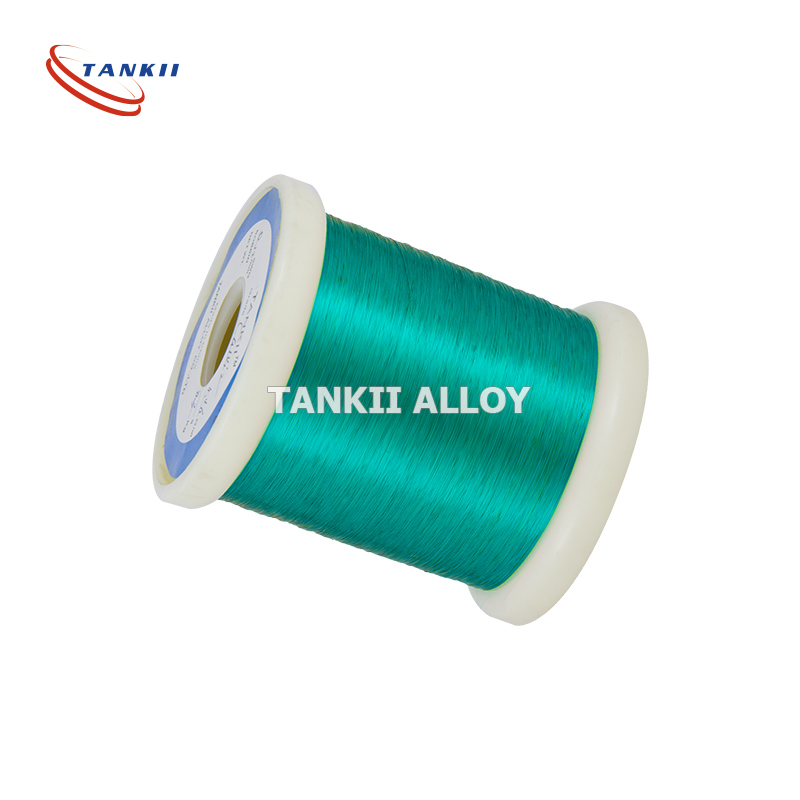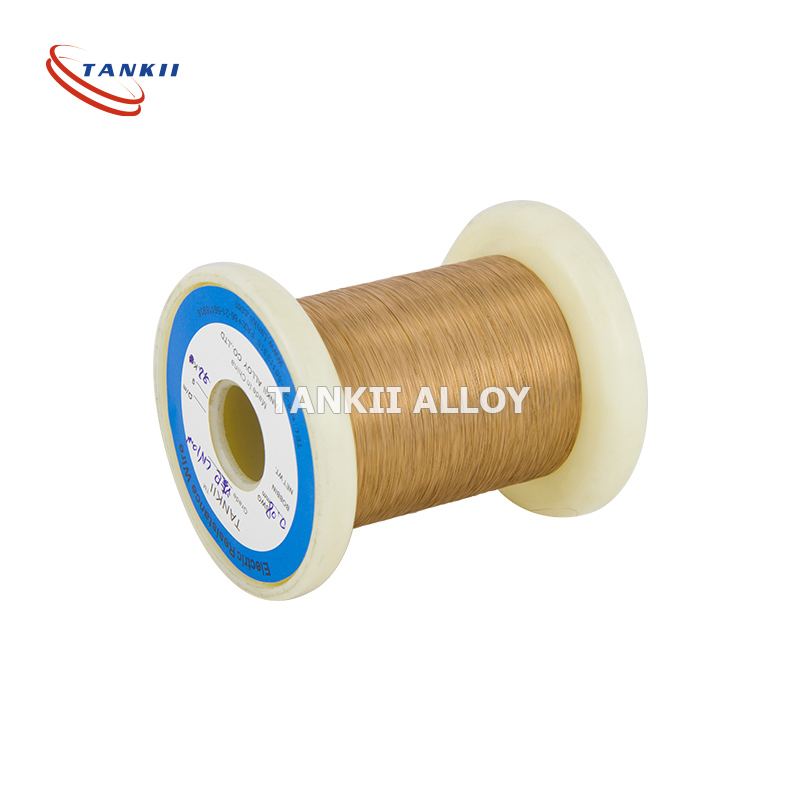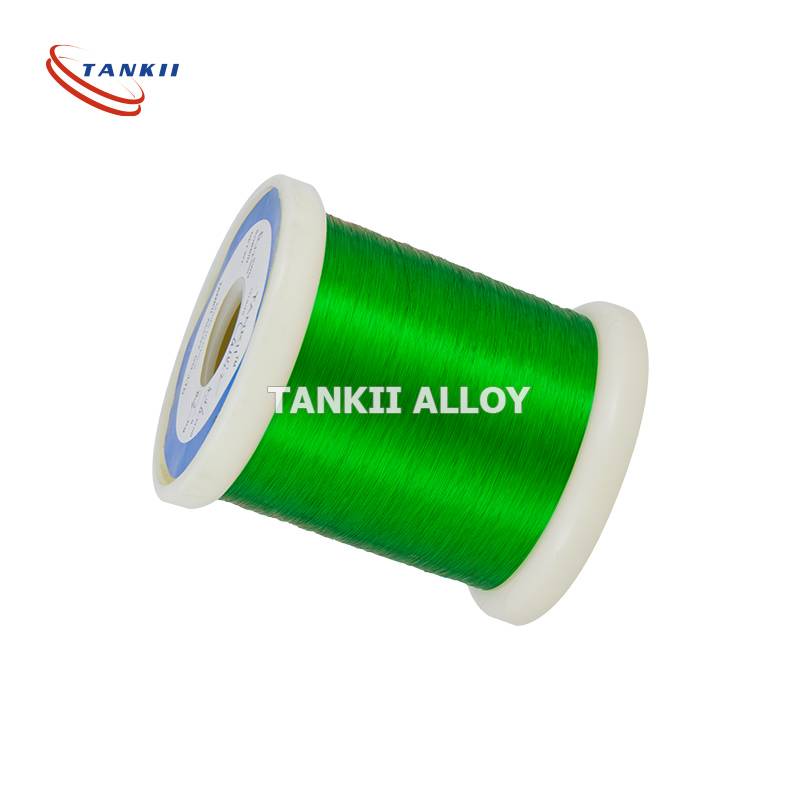0.2mm 130 Class Enameled Wire Colored Round Copper Alloy Manganin
130 Class Colored Round Copper Alloy Manganin Enameled Wire
1. Material General Description
Copper nickel alloy, which has low electric resisitance, good heat-resistant and corrosion-resistant, easy to be processed and lead welded. It is used to make the key components in the thermal overload relay, low resistance thermal circuit breaker, and the electrical appliances. It is also an important material for electrical heating cable. It’s similar as s type cupronickel.The more composition of Nickel,the more silver white the surface to be.
3.Chemical Composition and Main Property of Cu-Ni Low Resistance Alloy
| PropertiesGrade | CuNi1 | CuNi2 | CuNi6 | CuNi8 | CuMn3 | CuNi10 | |
| Main Chemical Composition | Ni | 1 | 2 | 6 | 8 | _ | 10 |
| Mn | _ | _ | _ | _ | 3 | _ | |
| Cu | Bal | Bal | Bal | Bal | Bal | Bal | |
| Max Continuous Service Temperature(oC) | 200 | 200 | 200 | 250 | 200 | 250 | |
| Resisivity at 20oC (Ωmm2/m) | 0.03 | 0.05 | 0.10 | 0.12 | 0.12 | 0.15 | |
| Density(g/cm3) | 8.9 | 8.9 | 8.9 | 8.9 | 8.8 | 8.9 | |
| Thermal Conductivity(α×10-6/oC) | <100 | <120 | <60 | <57 | <38 | <50 | |
| Tensile Strength(Mpa) | ≥210 | ≥220 | ≥250 | ≥270 | ≥290 | ≥290 | |
| EMF vs Cu(μV/oC)(0~100oC) | -8 | -12 | -12 | -22 | _ | -25 | |
| Approximate Melting Point( oC) | 1085 | 1090 | 1095 | 1097 | 1050 | 1100 | |
| Micrographic Structure | austenite | austenite | austenite | austenite | austenite | austenite | |
| Magnetic Property | non | non | non | non | non | non | |
| PropertiesGrade | CuNi14 | CuNi19 | CuNi23 | CuNi30 | CuNi34 | CuNi44 | |
| Main Chemical Composition | Ni | 14 | 19 | 23 | 30 | 34 | 44 |
| Mn | 0.3 | 0.5 | 0.5 | 1.0 | 1.0 | 1.0 | |
| Cu | Bal | Bal | Bal | Bal | Bal | Bal | |
| Max Continuous Service Temperature(oC) | 300 | 300 | 300 | 350 | 350 | 400 | |
| Resisivity at 20oC (Ωmm2/m) | 0.20 | 0.25 | 0.30 | 0.35 | 0.40 | 0.49 | |
| Density(g/cm3) | 8.9 | 8.9 | 8.9 | 8.9 | 8.9 | 8.9 | |
| Thermal Conductivity(α×10-6/oC) | <30 | <25 | <16 | <10 | <0 | <-6 | |
| Tensile Strength(Mpa) | ≥310 | ≥340 | ≥350 | ≥400 | ≥400 | ≥420 | |
| EMF vs Cu(μV/oC)(0~100oC) | -28 | -32 | -34 | -37 | -39 | -43 | |
| Approximate Melting Point( oC) | 1115 | 1135 | 1150 | 1170 | 1180 | 1280 | |
| Micrographic Structure | austenite | austenite | austenite | austenite | austenite | austenite | |
| Magnetic Property | non | non | non | non | non | non | |
2. Enamelled Wire Introduction and applications
Although described as “enameled”, enameled wire is not, in fact, coated with either a layer of enamel paint nor with vitreous enamel made of fused glass powder. Modern magnet wire typically uses one to four layers (in the case of quad-film type wire) of polymer film insulation, often of two different compositions, to provide a tough, continuous insulating layer. Magnet wire insulating films use (in order of increasing temperature range) polyvinyl formal (Formar), polyurethane, polyimide, polyamide, polyster, polyester-polyimide, polyamide-polyimide (or amide-imide), and polyimide. Polyimide insulated magnet wire is capable of operation at up to 250 °C. The insulation of thicker square or rectangular magnet wire is often augmented by wrapping it with a high-temperature polyimide or fiberglass tape, and completed windings are often vacuum impregnated with an insulating varnish to improve insulation strength and long-term reliability of the winding.
Self-supporting coils are wound with wire coated with at least two layers, the outermost being a thermoplastic that bonds the turns together when heated.
Other types of insulation such as fiberglass yarn with varnish, aramid paper, kraft paper, mica, and polyester film are also widely used across the world for various applications like transformers and reactors. In the audio sector, a wire of silver construction, and various other insulators, such as cotton (sometimes permeated with some kind of coagulating agent/thickener, such as beeswax) and polytetrafluoroethylene (PTFE) can be found. Older insulation materials included cotton, paper, or silk, but these are only useful for low-temperature applications (up to 105°C).
For ease of manufacturing, some low-temperature-grade magnet wire has insulation that can be removed by the heat of soldering. This means that electrical connections at the ends can be made without stripping off the insulation first.























